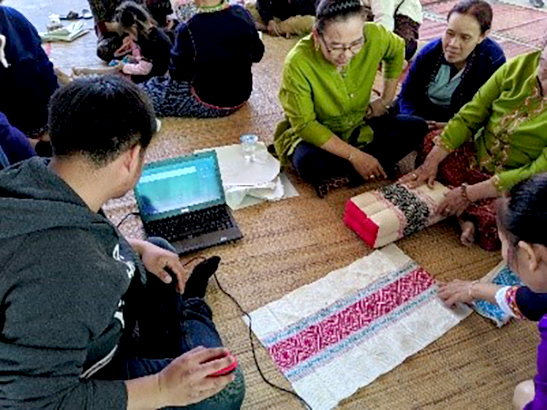Computerized Design for Hand-Woven Fabric Patterns for Contemporary Fashion at Kutwa Community Enterprise, Kalasin Province
Main Article Content
Abstract
Kutwa community enterprise, Kuchinarai district, Kalasin province is a group that gathers for fabric weaving and produces hand-woven cloth with the community’s distinctive identity. Products include shirts, bags, scarfs, shawls, hair ties, and loincloths, presented in local woven fabric patterns that are based on traditional styles and within a limited variety. Thus, the products may not attract a large group of customers. This research aims to promote the local hand-craft woven pattern design and develop contemporary fashion products. The research participants are five fabric design specialists and 30 members of Kut Wa subdistrict community enterprise group. The study follows these procedures: 1) Conceptualization and research process, 2) Community enterprise groups need analysis, 3) Collaboration with the community on fabric patterns design using a computerized design program, 4) Fabric pattern design based on local identity, 5) Analysis of fabric quality assessment and woven fabric pattern selection, 6) Prototyping the woven products, and 7) Distribution channeling. The project results in nine computerized design patterns of the hand-woven fabrics, as detailed: 1) Dok-wai pattern combined with pinwheels pattern 2) floating snake combined with Ya-Ku relics 3) Dok-Kaew Bamboo garland pattern 4) Big floating snake combined with ‘khit’ pattern 5) Phan Bai Sri decorated with Dok-Kaew and floating snake pattern 6) Pinwheel combined with bamboo garland and floating snake pattern 7) Human combined with half-Khit pattern 8) Kutwa bamboo garland pattern and 9) Dok-Kaew combined with Ton-Wha leaf pattern. These patterns are used to develop community products with various weaving patterns for customers’ choice. In conclusion, the enterprise group members have gained more income from an average of 70,000 baht per year to 80,000 -150,000 baht per year.
Article Details

This work is licensed under a Creative Commons Attribution-NonCommercial-NoDerivatives 4.0 International License.
Area Based Development Research Journal values copyright protection and licensing to safeguard author rights and facilitate the appropriate dissemination of research. Our policies ensure openness, accessibility, and attribution. Authors retain copyright ownership, and articles are published under a Creative Commons Attribution License (CC BY), allowing sharing, adaptation, and proper attribution. Authors have the freedom to publish under the CC BY license, granting broad reuse and distribution permissions. The journal supports posting articles on third-party repositories, adhering to institutional and funding restrictions. Author guidelines detail copyright and licensing requirements, empowering authors with knowledge about their rights and responsibilities. These policies cultivate an environment of collaboration, openness, and responsible sharing, benefiting authors and the research community while honoring intellectual property rights.
References
Boonyen, P. (2016). The phenomenon and context of the Kok Khong village, Kalasin province. (Master’s thesis). National Institute of Development Administration, Graduate School of Tourism Management. (in Thai).
Cohen, J., & Uphoff, N. (1981). Rural development participation: Concept and measure for project design implementation and evaluation. Rural Development Committee Center for International Studies. New York: Cornell University press.
Erwin, W. (1976). Electoral participation in a low stimulus election. Rural Development, 4(1), 111–124.
Jenjai, N. (2020). Upgrading Kai-weaved textiles for cultural products of the Mae Loi Luang community, Chiang Rai province. Area Base Development Research Journal, 12(2), 144-155. (in Thai).
Kurt, L. (1960). The dynamic of group action: Education leadership. New York: Henry Holt B. Co. Mueangkhwa, J. (2011). Artistic element 2 code PAI1107. Teaching materials. Suan Sunandha 27 Rajabhat University, Faculty of Painting, Sculpture and Graphic Arts. (in Thai).
Rampungjit, R., & Sorose, A. (2021). Souvenir product development of Sukhothai local sewing and craft of Khao Kaew Srisomboon community enterprise, Sukhothai province. Area Base Development Research Journal, 13(4), 268-278. (in Thai).
Suthipong, A., & Suwanawat, S. (2016). Design of Teenjok printing for creating contemporary fashion from Thai Phun Wisdom, Sukhothai. Art and Architecture Journal, Naresuan University, 7(2), 145-158. (in Thai).


